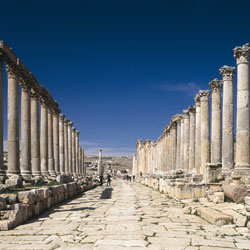|
JarashJerash, located 48Km north of the capital Amman, is considered to be one of the most important and best preserved Roman cities in the Middle East. It was a city of the Decapolis and it is known for the ruins of the Greco-Roman city of Gerasa or Antiochea, as known in the Bible. According to Mark 5:1f and Luke 8:26 - 39, here Jesus cast the evil spirits out of a man.
Within the remaining city walls, archaeologists have found the ruins of settlements dating back to the Neolithic Age, indicating human occupation at this location for more than 6500 years. This is not surprising, as the area is ideally suited for human habitation. Jerash has developed dramatically in the last century due to its strategic location in the heart of Jordan and the growing importance of the tourism industry to the city. Jerash is now the second-most popular tourist attraction in Jordan, closely behind the splendid ruins of Petra. Visitors to Jerash in late July or early August can enjoy the Jerash Festival of Culture and Arts an exciting celebration of both Jordanian and international culture. The ancient Roman amphitheater comes to life once more as dancers, musicians, acrobats, theatrical troupes and others from all over the world come to celebrate the link between ancient and modern culture in Jordan.
|
 The ruins have been carefully preserved and spared from encroachment, with the modern city sprawling to the west of ancient Jerash's city walls. To this day, its colonnaded streets, baths, theaters, plazas and arches remain in exceptional condition. The city also boasts well preserved monumental architectural parts: the Monumental Gate, the Nymphaeum and the Hippodrome. From the Byzantine period there are 18 churches, most of which have mosaic floors. The city wall with four gates is still preserved in many places.
The ruins have been carefully preserved and spared from encroachment, with the modern city sprawling to the west of ancient Jerash's city walls. To this day, its colonnaded streets, baths, theaters, plazas and arches remain in exceptional condition. The city also boasts well preserved monumental architectural parts: the Monumental Gate, the Nymphaeum and the Hippodrome. From the Byzantine period there are 18 churches, most of which have mosaic floors. The city wall with four gates is still preserved in many places.